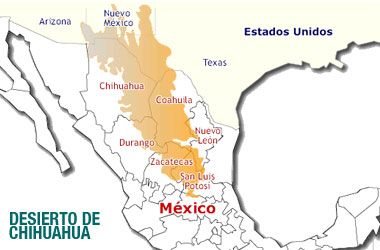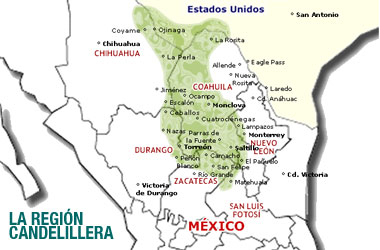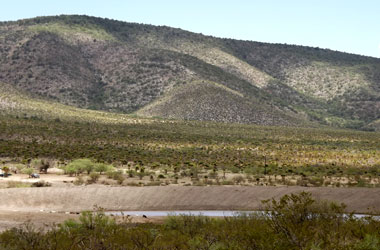Desierto de Chihuahua
La planta de Candelilla se desarrolla casi exclusivamente en una región semi-desértica de México, localizada dentro de la zona geográfica conocida con el nombre de «El Desierto de Chihuahua».

El Desierto de Chihuahua tiene una extensión de más de 450,000 km2 y se distingue como el desierto más grande de Norteamérica, con dimensiones aproximadas de 1,280 km de largo por 400 km de ancho. La mayor extensión del desierto se localiza en territorio Mexicano y comprende regiones de los estados de San Luis Potosí, Zacatecas, Coahuila, Durango y Chihuahua, extendiendo sus fronteras hacia los Estados Unidos con el sureste de los estados de Arizona, Nuevo México y con el sur de Texas.
Dos grandes cordilleras de montañas, la Sierra Madre Occidental por el oeste y la Sierra Madre Oriental por el este, bordean los límites del Desierto de Chihuahua. La presencia de estas montañas evita que las corrientes húmedas del Golfo de México y del Océano Pacífico precipiten en forma de lluvia, siendo esta la causa principal de la existencia de condiciones desérticas en la zona.
La elevación mínima del territorio del desierto se ubica a 300 m, aunque la mayor parte de su extensión se encuentra entre los 1,000 y 1,500 m de altura. Las temperaturas pueden ser extremas, con valores promedio de 13 °C en enero y de 36 °C en junio, pudiendo alcanzar los 50 °C en los días más calientes del año. La precipitación pluvial anual es menor de 350 mm, con 8 a 12 meses secos y con lluvias ocasionales durante los meses de enero, febrero, julio, agosto y septiembre.
El Desierto de Chihuahua es una de las zonas desérticas con mayor riqueza y diversidad biológica en el mundo. Sus condiciones particulares de humedad, composición del suelo y temperatura, permiten el crecimiento de casi una cuarta parte de las 1,500 cactáceas conocidas por la ciencia, así como de diversas especies florales que solo pueden desarrollarse en esta región del mundo, tal como es el caso de la planta de Candelilla.
La recolección de la Candelilla para la producción de cera natural ha sido una de las actividades económicas más importantes del Desierto de Chihuahua en cinco estados de la República Mexicana. Actualmente, se estima que hay más de 3,500 pequeños productores de cera de Candelilla en 230 ejidos de 33 municipios del noreste rural de México.
Sin embargo, la Candelilla se sigue explotando con las mismas técnicas arcaicas que se han mantenido intactas desde hace casi un siglo. Es prioritario incorporar prácticas de desarrollo sustentable para su cultivo y conservación, nuevas tecnologías de transformación y producción industrial, así como esquemas de organización productiva más eficientes.


